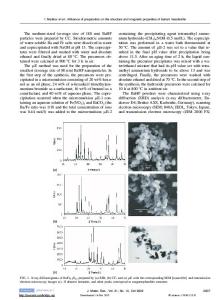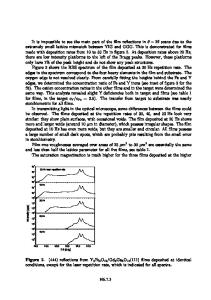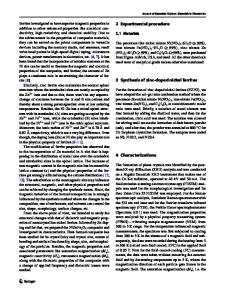The Influence of Ce-Cu Doping M-Type Strontium Hexaferrites on Structure and Magnetic Properties
- PDF / 2,558,894 Bytes
- 7 Pages / 595.276 x 790.866 pts Page_size
- 14 Downloads / 339 Views
ORIGINAL PAPER
The Influence of Ce-Cu Doping M-Type Strontium Hexaferrites on Structure and Magnetic Properties Zhanjun Zhang 1 Received: 25 May 2020 / Accepted: 28 July 2020 # Springer Science+Business Media, LLC, part of Springer Nature 2020
Abstract In this work, we reported the Ce-Cu co-substituted M-type strontium hexaferrites Sr0.7Ce0.3Fe12-xCuxO19 (0.00 ≤ x ≤ 0.50) prepared by using the solid-state method. The specific effect of Ce-Cu co-substitution on the magnetoplumbite structure and magnetic properties were studied systematically. The canonical M-type strontium hexagonal phase has been formed for our prepared sample in all doping range, which also has been confirmed by FTIR spectrum. In all compositional range, by the way, the magnetic competition of ferromagnetism-antiferromagnetism is reduced and gradually disappeared under the increasing substitution. Likewise, an obvious improvement of magnetic properties can be obtained; that is, Hc increases from 2850 to 3800 Oe and the value of Ms can reach up to 70.305 emu/g. The intrinsic stability and superior magnetic performance of such kind of material indicate a promising potential candidate in multilayer inductors. Keywords M-type hexaferrites . Magnetic properties . FTIR spectrum . FM-AFM
1 Introduction M-type strontium hexaferrites have always been an important functional material since it was discovered in 1950s [1]. This kind of magnetic material plays a decisive role in energy transformation and information processing, which can be seen widely no matter in our daily life or industrial production. The advantages of high cost performance and outstanding magnetic properties make it exhibits a durable part in magnetic field, such as permanent magnets [2], high-frequency devices [3], microwave devices [4], and absorbers of the EMR [5]. It is well known that M-type strontium hexaferrites can be expressed as SrFe12O19 (SrM), from where the 12 Fe and 19 O atoms constitute two basic structural units, namely, spinel S block (S = Fe6O82+) and hexagonal R block (R = SrFe6O112−) [6]. SrFe12O19 adopts a hexagonal close-packed crystal structure by a series of closepacked oxygen layers, which is built by placing S and R blocks upon each other through the stacking pattern of ···SRS*R*···
* Zhanjun Zhang [email protected] 1
School of Information & Electronic Engeering, Zhejiang Gongshang University, Hangzhou 310018, Zhejiang, China
(here, * refer to the 180° rotation around the hexagonal c-axis) [7]. In the SrM hexaferrite structure, Fe atoms are distributed to five different sublattices in the hexagonal structure (space group P63/mmc): they are 2a (octahedral site), 2b (trigonal bipyramidal), 12k (octahedral site), 4f1 (tetrahedral site), and 4f2 (octahedral site) [8]. Besides, in this different occupancy of Fe atoms, the magnetic orientation at 2a, 2b, and 12k sites exhibits spin up, while the magnetic direction at 4f1 and 4f2 orbits exhibits spin down [9]. Accordingly, SrFe12O19 exhibits a typical ferrimagnetic (FIM) state; among that, the upward magne
Data Loading...











